

Select 2) | and Patran Thermal reads the default TEMPLATE.BIN file in Patran Thermals root directory, as well as a local TEMPLATE.DAT file which may exist in the current directory. All the Patran Thermal files (TEMPDAT, CONDUCDAT, etc.) will be created in the local directory. |
Select 3) | only if VFAC boundary conditions were created for radiation in Patran. This will execute VIEW FACTOR in batch mode and create a VFRESDAT file that will be read later to create radiation resistors in the SINDA input format. |
Select 4) | if material properties (k, rho, or Cp) need to be automatically read from the Patran Thermal material library and inserted into the local MATDAT file. Otherwise this selection can be skipped. |
Select 6) | to access the utility menu which is also described in detail in section 3.2.2. The utility menu is where the actual translation to SINDA input occurs and is displayed on the next page. |
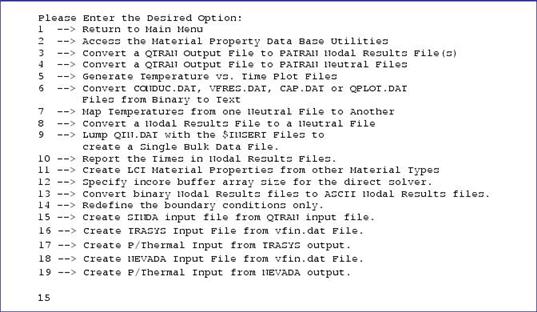
Select 15) | to create the SINDA input deck from existing Patran Thermal files created in the previous steps. |
Note: | It is recommended that all APPENDSIN files be deleted from the local directory before re-executing the SINDA utility if the run is being changed from steady-state to transient (or vice versa) or if the requested deck is being changed from SINDA85 to Network Analysis SINDA (or vice versa). |
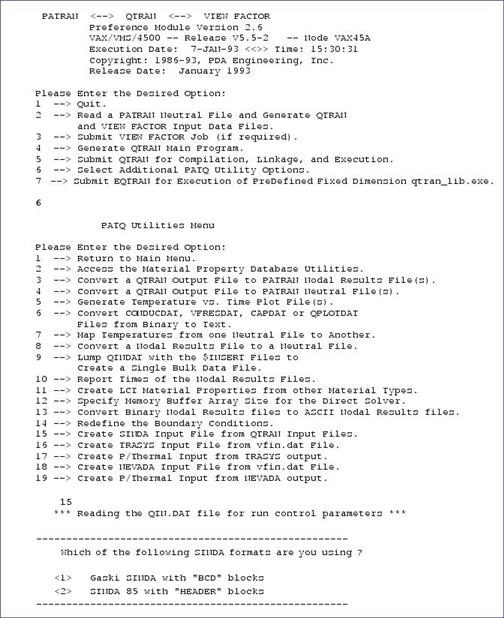
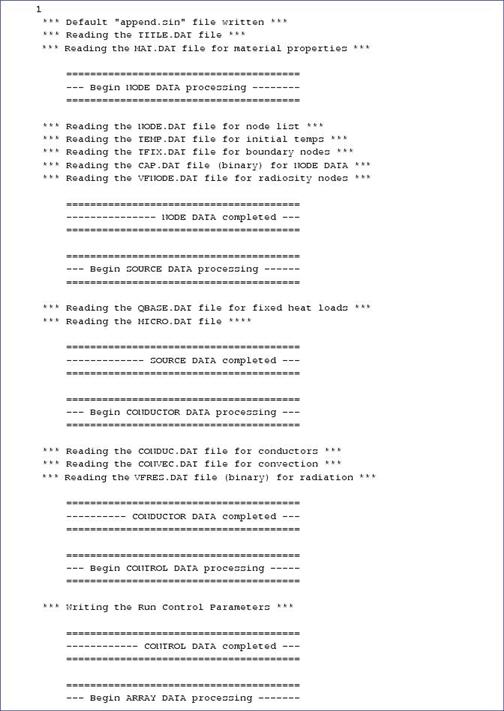
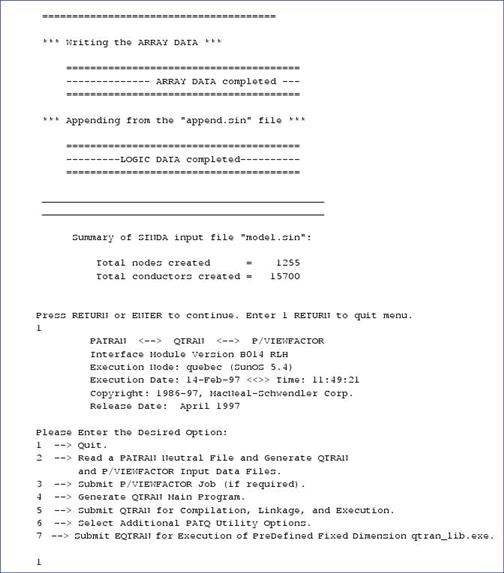
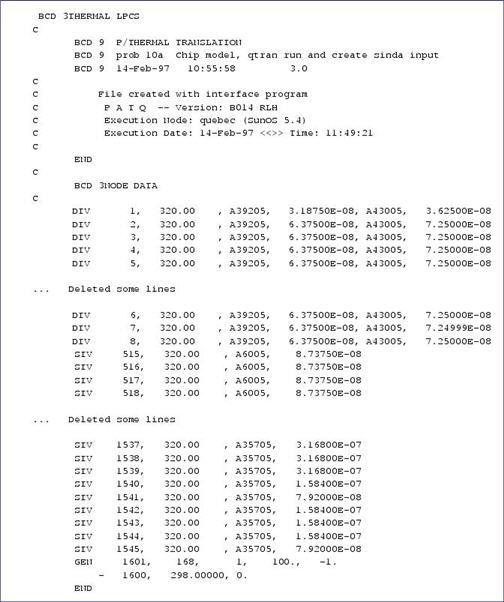
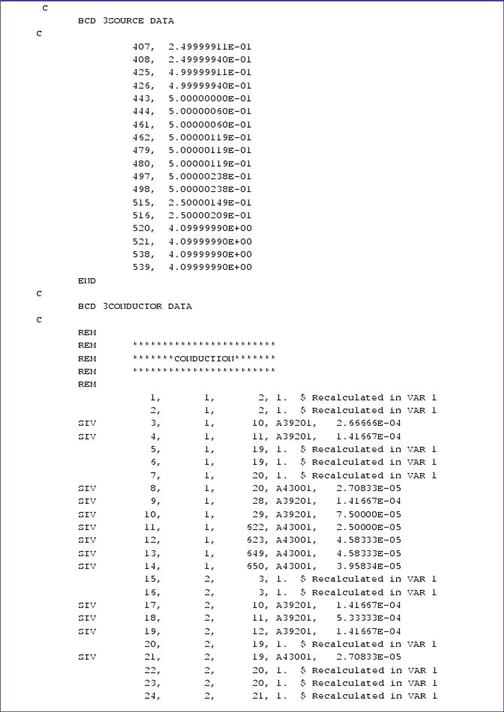
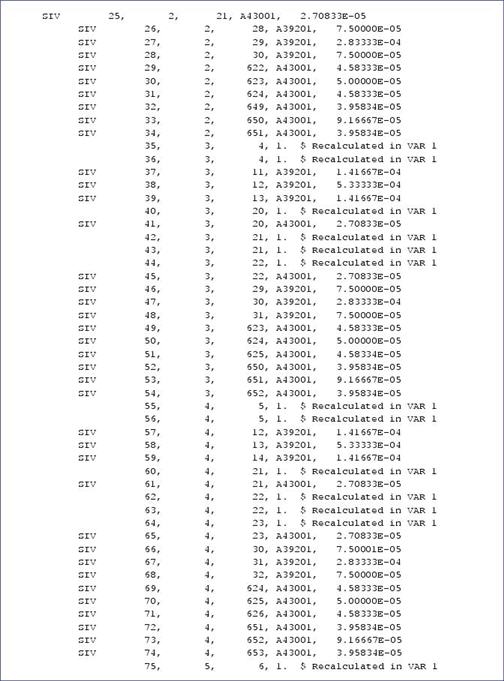
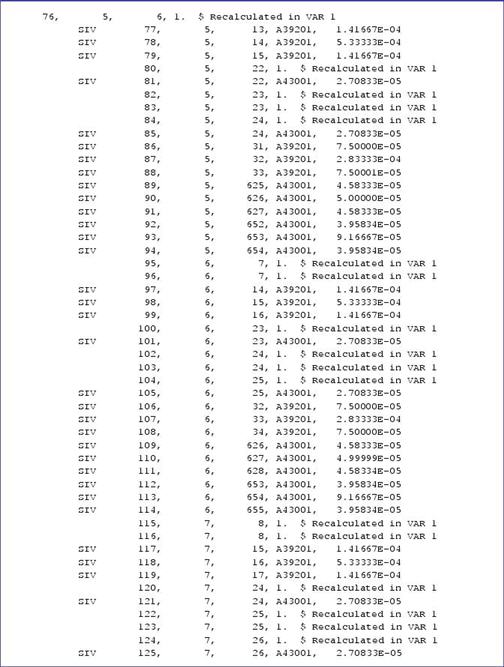
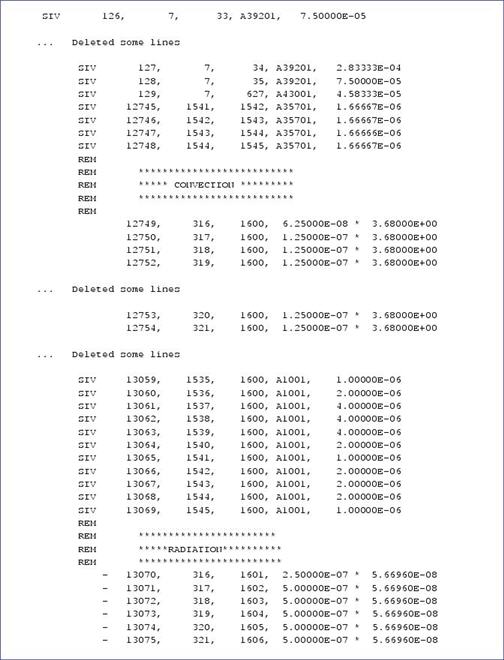
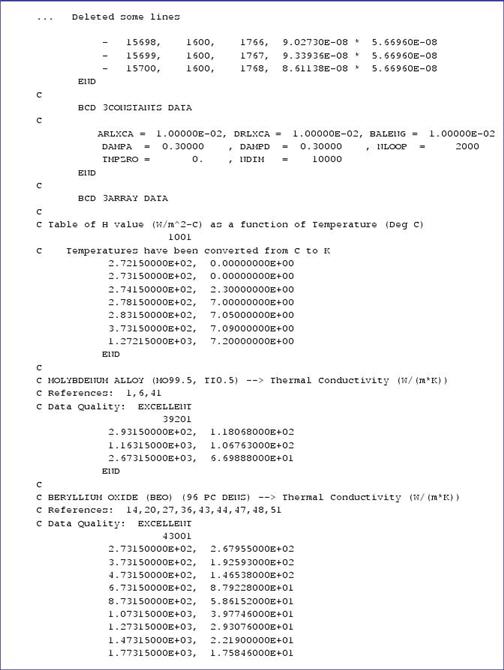
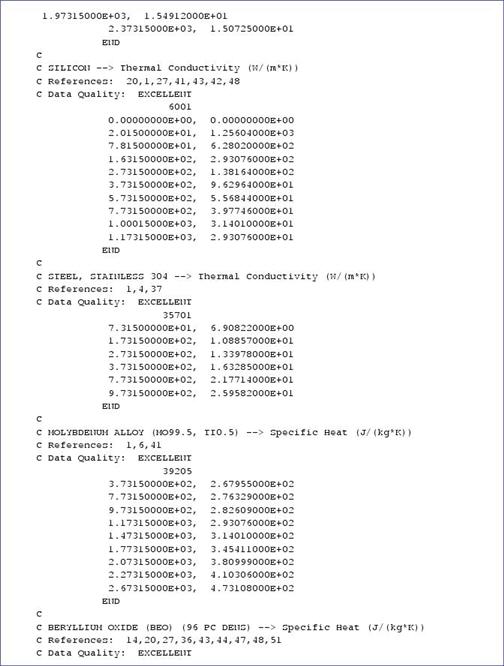
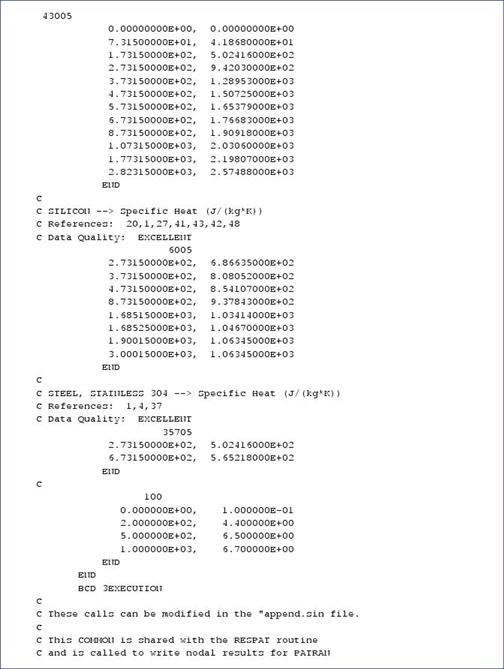
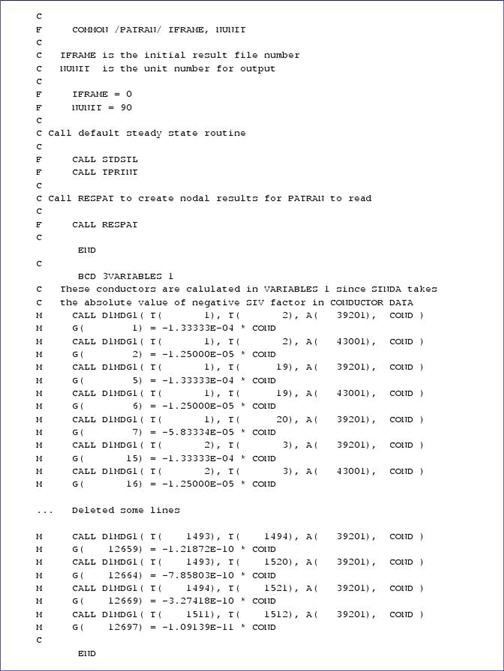
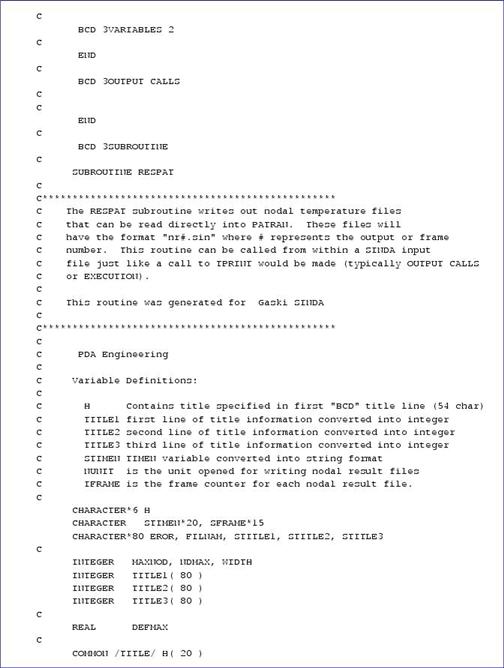
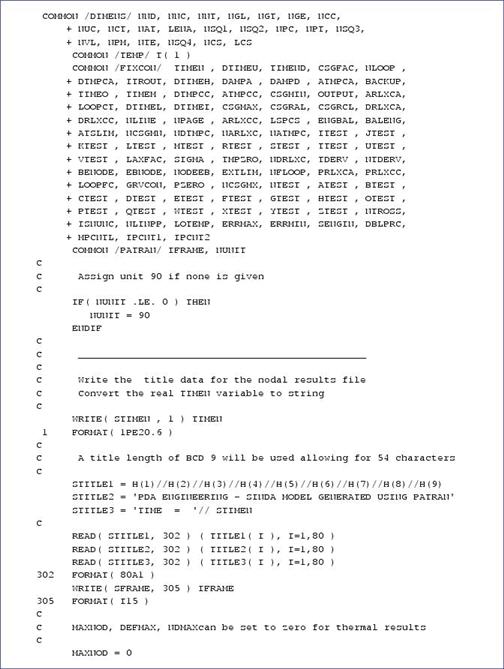
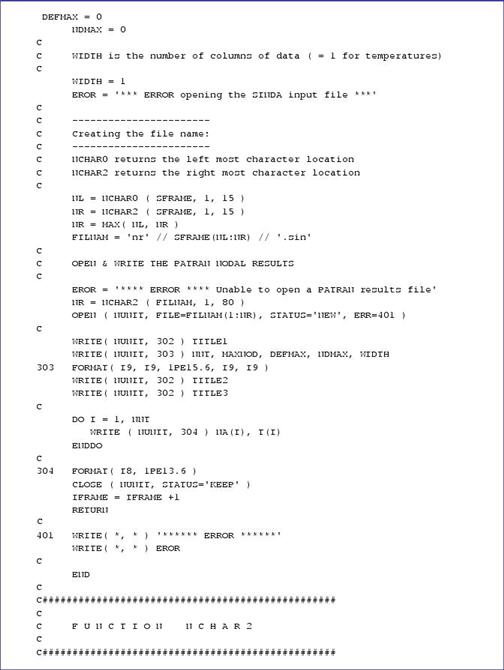
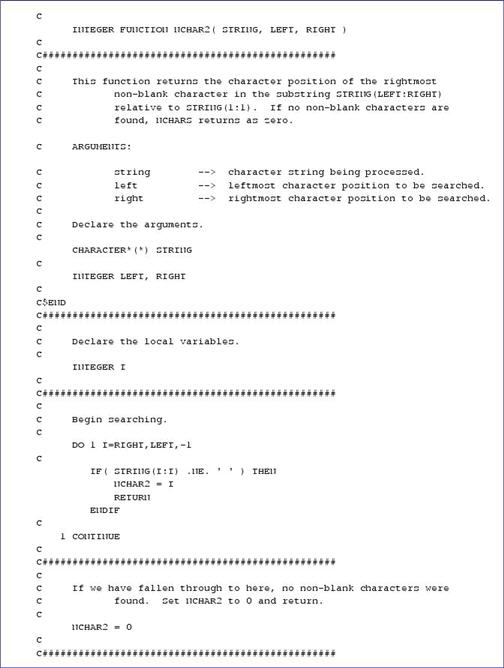
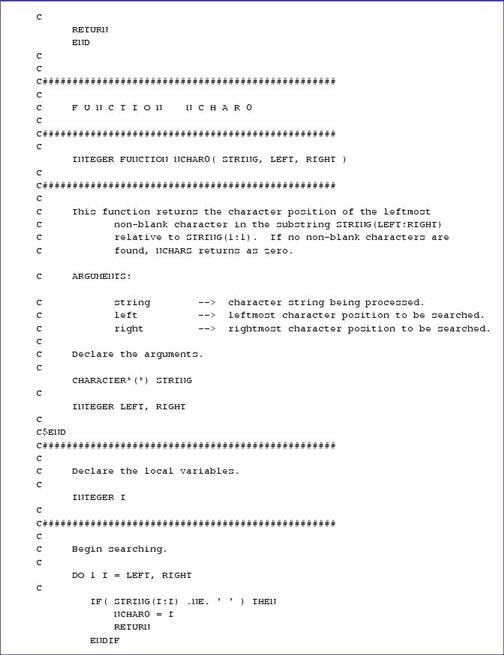
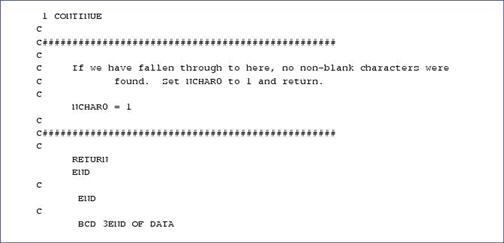
Patran Thermal to SINDA Functionality | |||
Functionality | Capability | Implementation | |
Node Data | Constant rho or Cp | MPIDs in MATDAT have IEVAL = “CONST”. | |
Constant rho, variable Cp | MPIDs in MATDAT have IEVAL = “CT” and “TABLE” or “ITABLE”. | ||
Constant Cp, variable rho | MPIDs in MATDAT have IEVAL = “C” and “TABLE” or “ITABLE”. | ||
Both rho & Cp variable | MPIDs in MATDAT have IEVAL “TABLE” or “ITABLE”. | ||
Both rho & Cp are massless | Advective, ambient, radiosity nodes, etc. | ||
Node has a fixed temp | TEMP LBC as fixed. | ||
Conduction | Constant Conductivity | MPID in MATDAT have IEVAL = “C”. | |
Temperature Variable | MPIDs in MATDAT have IEVAL “TABLE” or “ITABLE” | ||
Time Variable | MPIDS in MATDAT have IEVAL = “TABLE” or “IT” and ITSCAL=”T” in MATDAT. | ||
Convection | Constant “h” | CONV LBC with an “h” value | |
Spatial Variation | Use of a field | ||
Temp Variation | Conv Configuration 29 and ITSCAL=F, R, C, or K. | ||
Time Variation | Conv Configuration 29 and ITSCAL=T or MPID is “-” | ||
Radiation | Gray with fixed emissivity | VFAC has constant emissivity in TEMPLATE.DAT. | |
Advection | Flowrate | Cp | |
constant | constant | PFEG has fixed Mdot and MPID in MATDAT is constant. | |
time var | constant | ITSCAL in MATDAT is “T” for time. | |
temp var | constant | ITSCAL in MATDAT is F, R, C, or K. | |
constant | time var | ITSCAL in MATDAT is “T” for time. | |
time var | time var | ITSCALs are “T” for time for both Mdot and Cp. | |
temp var | time var | ITSCAL is “T” for time for Cp. | |
constant | temp var | ITSCAL in MATDAT is F,R,C, or K. | |
time var | temp var | ITSCAL in MATDAT is “T” for time for Mdot. | |
temp var | temp var | ITSCALs in MATDAT are F, R, C, or K. | |
Heat Source | Constant Q | HEAT LBC a fixed value or a function of Length, Area, or Volume. | |
temp variable | QMACRO function (must be with one micro 8 and with arg=1). | ||
time variable | QMACRO function (must be with one micro 8 and with arg.=0). | ||
Run Control | TMPZRO | Calculated from ICCALC from QINDAT. | |
Steady State or Transient | IOPT from QINDAT. | ||
NLOOP | IMAXSS for steady state, 50 for transient. | ||
TSTART | TSTART from QINDAT. | ||
TIMEND | TSTOP from QINDAT. | ||
DRLXCA, ARLXCA | EPSISS for Steady State and EPSIT for Transient. | ||
DAMPD,DAMPA | RELAXS for steady state RELAXT for transients. If IFXRLX is 1, then the smallest of the individual RLX options will be used as the DAMPX factor. | ||
SIGMA | This will be put directly into CONDUCTOR DATA. If SBC is “0” and ICCALC is C or K, then SBC=5.6698E-8. If SBC is “0” and ICCALC is F or R, then SBC=0.1712e-8. Otherwise, SBC is read directly from QINDAT. | ||
OUTPUT | TPRINT from QINDAT. | ||
Initial Temperatures | TINITL is read for initial temps in QINDAT but is overwritten by TEMP LBCs in Patran. | ||
Materials | Constant | ITSCAL=”C” in MATDAT. Lumped into capacitors and conductors. | |
ARRAY DATA | ITSCAL=”T” or “IT” in MATDAT (time or temp). Independent temperature columns are converted if CCALC is different than ITSCAL in MATDAT. FACTOR is multiplied by dependent column. | ||
Node Data | The nodes are written to the MODELSIN file in the NODE DATA block in the following order: diffusion (stores energy), arithmetic (massless), and boundary (fixed temperature). As shown in Table C‑12, a wide variety of options are possible for the NODE DATA block. An arithmetic node can be created with the NODE,#,ADD command in Patran. Nodes can have initial temperatures specified in Patran, otherwise the “TINITL” parameter in the QINDAT file is used to provide the initial temperatures. A node can also have a fixed temperature with the “-1” parameter specified in the TEMP LBC as described in Section 2.2.3.1 of this manual. Temperatures that reference macro and micro functions are not supported for this release. This functionality would be created by including the appropriate logic in the SINDA VARIABLES block. Currently, 62,400 is the maximum number of nodes per translation. |
Conduction | If the MATDAT file specifies the thermal conductivity to be “Constant”, then a constant conductor will be created in the SINDA deck. Time and temperature varying conductors will be created if the material property is input into the MATDAT file in a “TABLE” (or “ITABLE”). If ITSCAL is “T” for time, then a time varying conductor (SIT for Network Analysis' SINDA) will be created. See MPID Number, Function Type, Temperature Scale, Factor and Label (p. 263) in the Patran Thermal User’s Guide Volume 1: Thermal/Hydraulic Analysis under Material Properties (Ch. 8) for a description of ITSCAL and IEVAL. There is no limit to the maximum number of conductors per translation. |
Convection | Convection with a constant heat transfer coefficient is specified as described in Chapter 2 and also in sample problems 1 and 10. Problem 10 also demonstrates how convection can be specified as a function of temperature. This is done by creating a “CONV” template in the TEMPLATEDAT file which references configuration 29. This configuration points to a table of temperature versus heat transfer coefficient in the MATDAT file. Time varying convection is done in a similar way except ITSCAL for the convection MPID in the MATDAT file is “T” for time. Convection can also be created by referencing a spatial varying convection field or data entity (data line, data patch, or data hyperpatch). Other convection configurations are not supported by the SINDA utility. |
Radiation | Gray body radiation with fixed emissivity is supported as in Section 2.2.3.5 with the VFAC LBC and in the users manual. These radiation resistors are used in problem 10 and in all 3 example View Factor problems. Variable emissivity and spectral radiation are not supported for the SINDA utility. |
Advection | Variable and/or constant mass flow rate and specific heat are supported for advection. The hydraulic network functionality of Patran Thermal which calculates pressure drops and flow rates is not supported for the SINDA utility. |
Heat Source | Heat sources are applied by using the HEAT LBC for heat flux or nodal heat source respectively. Constant or variable heat values are supported. Variable heat sources are allowed by using a table of independent variable (time or temperature) versus heat with a MACRO function with microfunction 8. This is the only microfunction supported. For temperature varying sources, “ARG” is equal to “1” and for time varying sources, “ARG” is equal to “0” as specified in MFID, Independent Variable, and Function Type (p. 323) in the Patran Thermal User’s Guide Volume 1: Thermal/Hydraulic Analysis under Microfunction Data (Ch. 8). |
Run Control | The run control parameters are taken from the QINDAT file in the local directory. It is important to note that the SINDA utility will NOT look for any nodes or resistors inserted directly into the QINDAT file. It will only read these nodes and resistors from the appropriate files (nodedat, resdat, etc.) Table C‑12 shows which run control parameters are read. All other parameters in the QINDAT file are ignored. |
Materials | If the IEVAL parameter of the material property (MPID) in the MATDAT file is T (or “IT”) for table, then the table will be put into ARRAY DATA. If the value of ITSCAL (also in the MATDAT file) is different than the value of ICCALC in the QINDAT file, then a conversion of the temperatures in the MATDAT file will take place to match the temperature units specified by ICCALC (the calculation units). A message in the array will note that this has taken place. Any of the thermal conductivities and specific heats in the Patran Thermal material library that are tables can be brought into ARRAY DATA. The phase change properties in the MATDAT file will be ignored by the SINDA utility. |
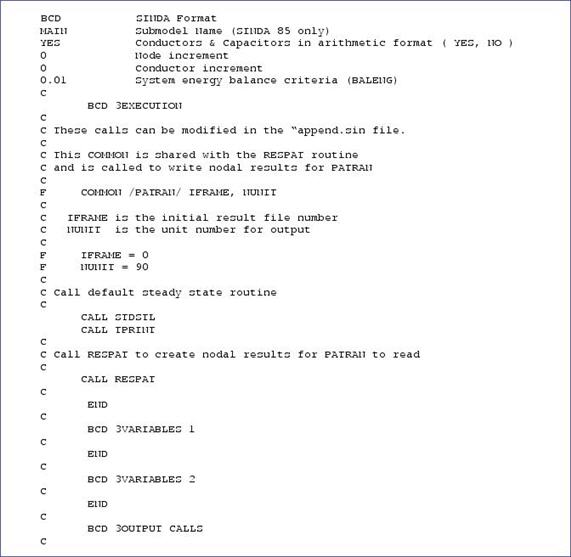
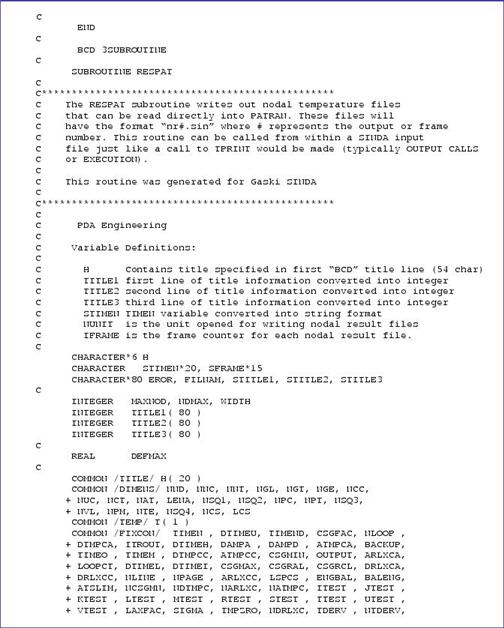
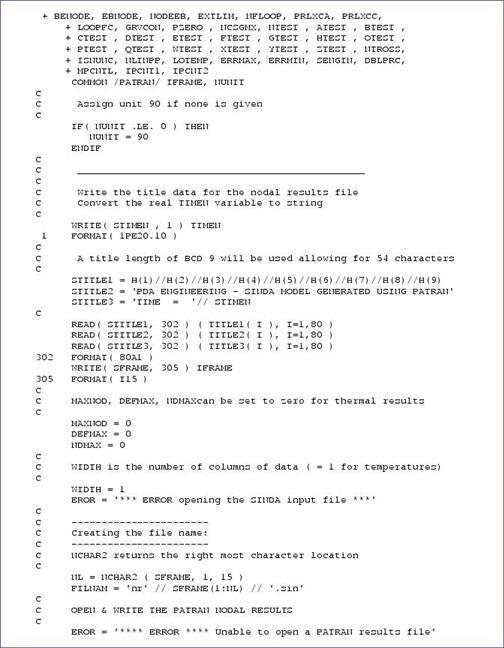
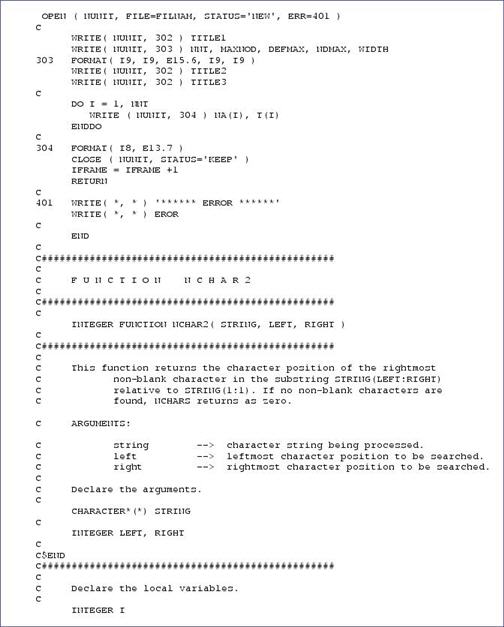
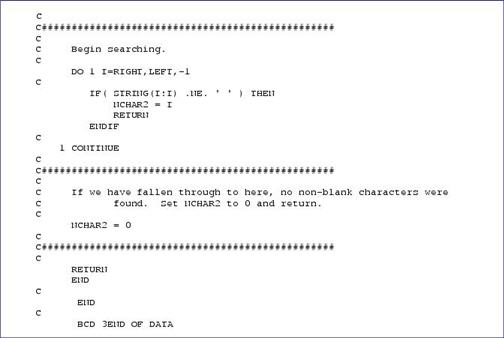
SINDA Format | The choices are “BCD” or “HEADER”. This signifies that this file is created for Network Analysis’ “BCD” format SINDA or SINDA ‘85 with “HEADER” format. It is recommended that all APPENDSIN files be deleted from the local directory before re-executing the SINDA utility if the run is being changed from SINDA '85 to Network Analysis’ SINDA (or vice versa). The SINDA utility will prompt the user as to which type of SINDA file should be created next time since an APPENDSIN file no longer exists in the local directory. Since the default versions of SINDA do not support a negative shape factor (area/length) in SIV statements, a temporary value of 1.0 is assigned in the CONDUCTOR block for the negative cross-derivative terms which are recalculated in VARIABLES 1. If the SIV has been modified to accept a negative shape factor (without taking the absolute value) then the term FIXBCD or “FIXHEADER” can be used which will direct the utility to allow SIV statements with a negative shape factor. These cross-derivative conductors are the key to the inherent accuracy of Patran Thermal’s conductor network. |
Submodel Name | This is the SINDA ‘85 submodel name and is only relevant for SINDA 85. This line must exist in the APPENDSIN for both types of SINDA but is ignored for Network Analysis’ SINDA. |
Conductors & capacitors in arithmetic format (YES, NO) | If YES (default) is entered, then all of the information in NODE DATA and CONDUCTOR DATA blocks will be entered with arithmetic operators (typically with the multiplier symbol "*"). If NO is entered, then all values for a node or conductor entry will be entered as a single value. |
Node increment | This value is the increment for each node in the Patran model. Node 1 in the Patran model will become node 2001 if the increment is set to 2000. This might be used if multiple Patran models need to be combined into one SINDA deck. This option should be used with caution since the Patran nodes must correspond to the SINDA nodes for postprocessing in Patran. |
Conductor increment | This value is the increment for conductors in the SINDA input file. If the increment is set to 1000, then the first conductor in the SINDA input file will be 1001. This might be used if multiple Patran models need to be combined into one SINDA deck. |
System energy balance criteria (BALENG or EBALSA) | This is the system energy balance criteria. For Network Analysis SINDA, this is the BALENG value. For SINDA 85, this is the EBALSA value. The default value is 0.01. |